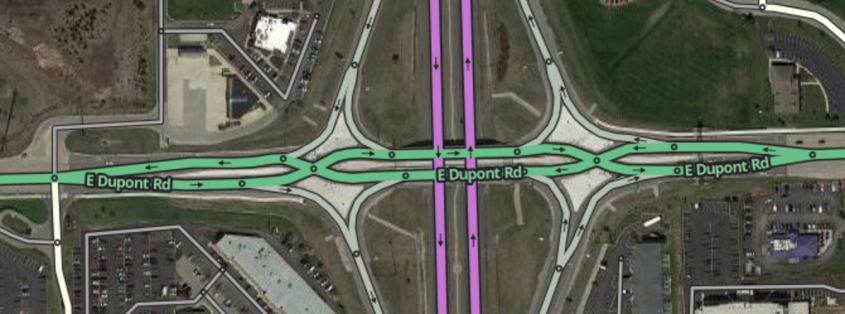TerryPurdue (talk | contribs) |
Kartografer (talk | contribs) m (removed bold on headings) |
||
| (45 intermediate revisions by 4 users not shown) | |||
| Line 1: | Line 1: | ||
== Diverging | == Diverging diamond interchange (DDI) == | ||
''See also:'' [https://en.wikipedia.org/wiki/Diverging_diamond_interchange Diverging Diamond Interchange] article on Wikipedia. | ''See also:'' [https://en.wikipedia.org/wiki/Diverging_diamond_interchange Diverging Diamond Interchange] article on Wikipedia. | ||
[[File:DDI Example Dupont.png|thumb|845x845px|none]] | |||
Diverging diamond interchanges (DDI) are a type of diamond interchange in which the two directions of traffic cross one another on each side of a limited-access roadway. A DDI may pass over or under the limited-access roadway. | |||
This type of interchange is unusual, in that it requires traffic to briefly drive on the opposite side of the road from what is customary for the jurisdiction. However, the design of the Diverging Diamond Interchange controls the driver's line of sight to ensure the cross-over action feels natural and goes unnoticed. | |||
=== Segment directionality === | |||
[[File:DDI Example Dupont - traffic flow.png|thumb|848x848px|Flow of traffic within a Diverging Diamond Interchange|none]] | |||
All ramp and surface street segments are set as one-way. If you are creating a DDI along a road which is not divided, divide the road, first. See'' h[[usa:Best_map_editing_practice#Dividing_and_un-dividing_divided_highways|ow to properly divide/un-divide a road.]]'' | |||
=== At- | === At-grade intersections === | ||
==== Junctions ==== | ==== Junctions ==== | ||
As with all at-grade intersections in Waze, all DDI at-grade intersections are modeled with junction points, ''including'' the two signaled intersections where opposing directions of traffic "cross over" each other (inner surface road junctions). A DDI may also have two outer surface road junctions, where the one-way segments transition to two-way road segments. | |||
==== Turn restrictions ==== | |||
===== Overview ===== | |||
There are four junctions in a DDI at which the turn restrictions must be checked - two inner surface road junctions where traffic crosses, and two outer surface road junctions where the road divides/joins on each side of the DDI.[[File:DDI Example Dupont - turn restrictions.png|thumb|871x871px|All restricted turns within a DDI (displayed by using Shift+Z).|none]] | |||
Disable the | ===== Inner surface road junctions ===== | ||
[[File:DDI Example Dupont - turn restrictions - inner - 01.png|none|thumb|871x871px]] | |||
[[File:DDI Example Dupont - turn restrictions - outer - 02.png|none|thumb|870x870px]]Disable the ''two'' turns from one-way segments to the segments carrying traffic the ''opposite'' direction at both inner surface road intersections, for a total of four disabled turns. | |||
''' | ===== Outer surface road junctions ===== | ||
[[File:DDI Example Dupont - turn restrictions - outer.png|none|thumb|871x871px]] | |||
Disable the ''single'' turn from the one-way segment carrying traffic ''exiting'' the DDI to the one-way segment carrying traffic ''entering'' the DDI at both outer surface road intersections, for a total of two disabled turns. | |||
=== Elevations === | |||
Elevations are set relative to the limited-access road passing over or under the DDI, with all segments that connect at at-grade intersections having identical elevation. | |||
Latest revision as of 14:38, 18 April 2017
Diverging diamond interchange (DDI)
See also: Diverging Diamond Interchange article on Wikipedia.

Diverging diamond interchanges (DDI) are a type of diamond interchange in which the two directions of traffic cross one another on each side of a limited-access roadway. A DDI may pass over or under the limited-access roadway.
This type of interchange is unusual, in that it requires traffic to briefly drive on the opposite side of the road from what is customary for the jurisdiction. However, the design of the Diverging Diamond Interchange controls the driver's line of sight to ensure the cross-over action feels natural and goes unnoticed.
Segment directionality

All ramp and surface street segments are set as one-way. If you are creating a DDI along a road which is not divided, divide the road, first. See how to properly divide/un-divide a road.
At-grade intersections
Junctions
As with all at-grade intersections in Waze, all DDI at-grade intersections are modeled with junction points, including the two signaled intersections where opposing directions of traffic "cross over" each other (inner surface road junctions). A DDI may also have two outer surface road junctions, where the one-way segments transition to two-way road segments.
Turn restrictions
Overview
There are four junctions in a DDI at which the turn restrictions must be checked - two inner surface road junctions where traffic crosses, and two outer surface road junctions where the road divides/joins on each side of the DDI.

Inner surface road junctions


Disable the two turns from one-way segments to the segments carrying traffic the opposite direction at both inner surface road intersections, for a total of four disabled turns.
Outer surface road junctions

Disable the single turn from the one-way segment carrying traffic exiting the DDI to the one-way segment carrying traffic entering the DDI at both outer surface road intersections, for a total of two disabled turns.
Elevations
Elevations are set relative to the limited-access road passing over or under the DDI, with all segments that connect at at-grade intersections having identical elevation.